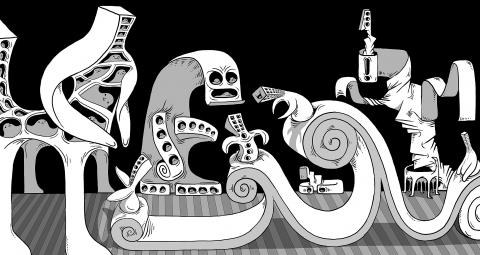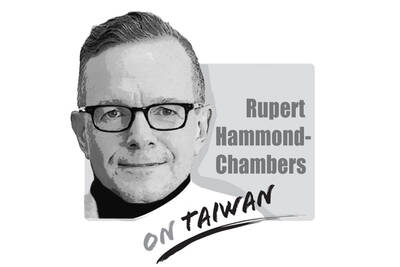Vietnam seems to be the consensus pick for winner of the US-China trade war, as Chinese and other manufacturers shift production to the cheaper Southeast Asian nation. If there is a loser, at least in terms of missed opportunities, it might be the countries of South Asia.
To understand why, remember that the trade war has only accelerated an important trend a decade in the making. Faced with rising costs, Chinese manufacturers must decide whether to invest in labor-saving automation technologies or to relocate.
Those choosing the latter present an enormous opportunity for less-developed countries, as Chinese companies could help spark industrialization and much-needed economic transformation in their new homes.

Illustration: Mountain People
There might not be another such chance this generation. The only proven pathway to long-lasting, broad-based prosperity has been to build a manufacturing sector linked to global value chains, which raises productivity levels and creates knock-on jobs across the whole economy.
This was how most rich nations, not to mention China itself, lifted themselves out of poverty.
Yet the evidence suggests that South Asian countries are lagging behind in attracting manufacturing investment. It is not just Vietnam that is racing ahead.
African countries, too, are making manufacturing a top priority. Ethiopia alone has opened nearly a dozen industrial parks in recent years and set up a world-class government agency to attract foreign investment. The World Bank has lauded sub-Saharan Africa as the region with the highest number of reforms each year since 2012.
By contrast, in terms of foreign direct investment (FDI) as a percentage of GDP, South Asia lags both the global average for least-developed countries and sub-Saharan Africa.
While South Asia’s total GDP is more than 70 percent greater than Africa’s, the continent received three-and-a-half times the investment from China that South Asia received in 2012, the most recent year for which the UN has published bilateral FDI statistics.
In the last five years, the American Enterprise Institute’s China Global Investment Tracker has recorded 13 large Chinese investment deals in Africa and only nine in South Asia.
Bangladesh is a striking illustration of the problem. The country needs to create 2 million jobs per year at home just to keep up with its growing population.
Yet, despite a world-class garments manufacturing sector, it seems unable to cut red tape and enact the reforms needed to attract investment to diversify beyond apparel.
In the past few years, Bangladesh has fallen to 176 out of 190 countries in the global Ease of Doing Business country rankings.
DBL Group, a Bangladeshi company, is investing in a new apparel manufacturing facility that would generate 4,000 jobs — in Ethiopia.
The fantasy, most common in India, that a country might somehow “leapfrog” from a rural, agriculture-heavy economy straight to a services-based economy is just that: a fantasy. South Asia cannot afford to lose this chance to grow its manufacturing sector.
Attracting manufacturing investments would require, first and foremost, that governments in the region acknowledge the competition is passing them by.
India, for example, must abandon its overconfidence that investors would come simply for its large population.
Pakistan needs to stop relying on its government-to-government friendship with China. Chinese state financing of infrastructure would not automatically lead to manufacturing investment, most of which is dominated by private Chinese companies motivated by competitive forces, not government diktats.
Second, South Asian countries need to undertake a concerted, whole-of-government push to boost investment levels.
Specifically, they need to create the conditions manufacturers need to thrive, from steady power supplies to efficient port operations and customs clearance.
Moreover, they need to understand the specifics of these businesses. Factories have unique requirements depending on what they make. For example, cloth and clothing factories, despite their seeming similarities, have extremely different requirements:
The former is capital-intensive, with huge amounts of power-hungry machinery churning out bolts of cloth, whereas the latter is labor-intensive and features rows of workers cutting and sewing.
Countries need to analyze which manufacturing sub-sectors they are best positioned for, meet the requirements those manufacturers have in order to set up shop, and target the regions of China (and elsewhere in the world) where those types of manufacturers are to be found.
The good news is that all of these measures are eminently feasible. In many cases, the first steps are already being taken, such as with the construction of Bangladesh’s first deep sea port at Matarbari.
The bad news is that unless South Asia moves faster, others might have already seized the opportunity to industrialize.
Irene Yuan Sun is a visiting fellow at the Center for Global Development and a research fellow at the Harvard Humanitarian Initiative.
The gutting of Voice of America (VOA) and Radio Free Asia (RFA) by US President Donald Trump’s administration poses a serious threat to the global voice of freedom, particularly for those living under authoritarian regimes such as China. The US — hailed as the model of liberal democracy — has the moral responsibility to uphold the values it champions. In undermining these institutions, the US risks diminishing its “soft power,” a pivotal pillar of its global influence. VOA Tibetan and RFA Tibetan played an enormous role in promoting the strong image of the US in and outside Tibet. On VOA Tibetan,
Former minister of culture Lung Ying-tai (龍應台) has long wielded influence through the power of words. Her articles once served as a moral compass for a society in transition. However, as her April 1 guest article in the New York Times, “The Clock Is Ticking for Taiwan,” makes all too clear, even celebrated prose can mislead when romanticism clouds political judgement. Lung crafts a narrative that is less an analysis of Taiwan’s geopolitical reality than an exercise in wistful nostalgia. As political scientists and international relations academics, we believe it is crucial to correct the misconceptions embedded in her article,
Sung Chien-liang (宋建樑), the leader of the Chinese Nationalist Party’s (KMT) efforts to recall Democratic Progressive Party (DPP) Legislator Lee Kun-cheng (李坤城), caused a national outrage and drew diplomatic condemnation on Tuesday after he arrived at the New Taipei City District Prosecutors’ Office dressed in a Nazi uniform. Sung performed a Nazi salute and carried a copy of Adolf Hitler’s Mein Kampf as he arrived to be questioned over allegations of signature forgery in the recall petition. The KMT’s response to the incident has shown a striking lack of contrition and decency. Rather than apologizing and distancing itself from Sung’s actions,

US President Trump weighed into the state of America’s semiconductor manufacturing when he declared, “They [Taiwan] stole it from us. They took it from us, and I don’t blame them. I give them credit.” At a prior White House event President Trump hosted TSMC chairman C.C. Wei (魏哲家), head of the world’s largest and most advanced chip manufacturer, to announce a commitment to invest US$100 billion in America. The president then shifted his previously critical rhetoric on Taiwan and put off tariffs on its chips. Now we learn that the Trump Administration is conducting a “trade investigation” on semiconductors which